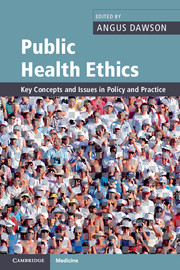Book contents
- Frontmatter
- Contents
- List of contributors
- Preface
- Acknowledgements
- Section 1 Concepts
- Section 2 Issues
- 5 Smoking, health and ethics
- 6 Infectious disease control
- 7 Population screening
- 8 Vaccination ethics
- 9 Environment, ethics and public health
- 10 Public health research ethics
- 11 Equity and population health
- 12 Health inequities
- Index
- References
11 - Equity and population health
Toward a broader bioethics agenda
Published online by Cambridge University Press: 05 July 2011
- Frontmatter
- Contents
- List of contributors
- Preface
- Acknowledgements
- Section 1 Concepts
- Section 2 Issues
- 5 Smoking, health and ethics
- 6 Infectious disease control
- 7 Population screening
- 8 Vaccination ethics
- 9 Environment, ethics and public health
- 10 Public health research ethics
- 11 Equity and population health
- 12 Health inequities
- Index
- References
Summary
Introduction
In its early decades, bioethics concentrated on two important problem areas: (1) the dyadic, very special relationships that hold between doctors and patients and researchers and subjects; and (2) Promethean challenges, the powers and responsibilities that come with new knowledge and technologies in medicine and the life sciences, including those that bear on extending and terminating life. The dyadic relationships yield important goods, impose significant risks, are rife with inequalities in power and authority, and yet are bound by complex rights and obligations. They provide a rich field for ethics to explore. The Promethean challenges are the favourites of the media: how god-like can we become in our relations with people, with animals, and with our environment without losing our moral footing? They attract serious inquiries about how to use knowledge and technology responsibly for the individual and collective good. Unfortunately, they also form the frontline trenches for contemporary culture wars.
Bioethics' focus on the largely non-institutional examination of these dyadic relations and the emergence of exotic technologies means other important issues concerning population health and its equitable distribution were not addressed. (There are exceptions to this generalization.) The doctor–patient relationship and the researcher–subject relationship do have a bearing on population health, since medicine and medical research have impact on the health of individuals and populations. By not examining the broader institutional settings and policies that mediate population health, bioethics has sometimes been myopic, not seeing the context in which these relationships operate.
- Type
- Chapter
- Information
- Public Health EthicsKey Concepts and Issues in Policy and Practice, pp. 191 - 210Publisher: Cambridge University PressPrint publication year: 2011
References
- 3
- Cited by



